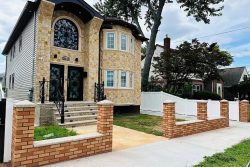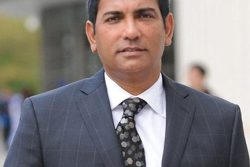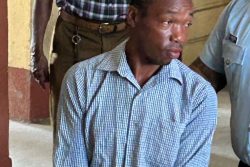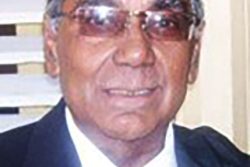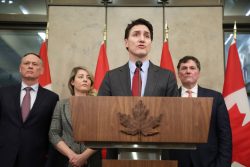Amid the debate about the suitability of the Bell 206 helicopter in assisting the Joint Services in fighting crime, the army yesterday made it clear that it was extremely comfortable with the acquisition, saying the machines were checked and inspected by its engineers and are affordable to maintain.
It also said that its decision to consult or not with experts in the helicopter or aviation industry for that matter “is the business of the GDF and not the fantasy of acid critics”.
One of the helicopters is already in the army’s possession while another of the same make is expected in another ten days .
At a press conference yesterday, army Chief-of-Staff, Commodore Gary Best, said the force found it necessary to bring some perspective to the controversy surrounding the acquisition of the two Bell 206 B 3 Jet Ranger helicopters. This was the only issue that the press conference addressed.Best explained that the helicopter forms part of a strategic plan by the Guyana Defence Force to resource its aviation unit with reconnaissance, medium life and troop transport capability over a phased period. He said the helicopters are primarily for reconnaissance missions and tactical insertions of forward exploration troops. “They were not purchased as medium lift helicopters,” he asserted.
Prior to the arrival of the first helicopter, there was much talk about it boosting the force’s capacity to track down gangs of gunmen, in the wake of the Lusignan and Bartica killings.
Best told reporters that the force has recognised that medical evacuation and search and rescue missions are critical to a secure environment and to that extent the GDF acquired the helicopters which are accessorised to execute medical and search and rescue missions. He said the army also recognised that the night operations were essential to criminal mission success and that the helicopter already here would be accessorised accordingly. He said the second chopper would come fully equipped.
“So we now have two helicopters capable of conducting law enforcement operations, medical evacuations and search and rescue. These are multi-mission helicopters,” Best said.
He said both helicopters would be equipped with stretchers to conduct medical evacuations and additional equipment installed includes a Skytrax tracking system, terrain alert global positioning system, a night sun, which allows for the illumination of a large area at night, a loud hailer and siren system and forward looking infrared system, allowing for information acquisition.
He said both choppers had 100 hours warranty and were advertised on an ‘as is where is’ basis which is standard in the industry but were upgraded significantly.
He said GDF engineers were present at most of the upgrades conducted in Costa Rica and the United States and conducted final inspections before recommending closing of purchases.
Turning to the many criticisms being levelled at the first chopper, including its 10,000 flying hours and single engine, Best argued that the airframe time for the Bell 206 was unlimited, once the requisite inspections were done. According to him, both helicopters were recently inspected by the US Federal Aviation Administration and were issued with certificates of airworthiness by the same body.
He argued too that once an aircraft has a limitless airframe time, the component timings on it assumes importance. “Once these components are changed at stipulated timings they then give the aircraft its newness.
Both helicopters have excellent component time with an average 75% life remaining on their major components,” he asserted.
Further, the army chief said the GDF anticipated one and a half to two years maintenance-free time on each of the helicopters.
Best also said that the flight manual of the helicopter indicates that it could fly at night, under certain conditions. Asked later to explain those conditions, Best referred the question to Chief Pilot Major Mike Charles who explained that the copter’s night flying capacity was limited. He added that there was no doubt that the helicopter could fly at night but there must be light in the route it was flying.
“It can fly at night yes, but if you go into the dark it cannot work. There must be light on the ground,” he explained.
Best said the army over the years has been engaging in night flying with its previous 206 helicopter that was in its possession.
He said the aircraft were acquired primarily to function in the aerial reconnaissance role and as such, troop transportation was not a preeminent criterion. He said that to transport in the vicinity of eight to ten men would require a medium lift helicopter of the 412 type, which the GDF already has, but which is not currently in operation.
Asked later about the state of the Bell 412, which is now parked at the army’s camp at Tacama, he said it was being repaired and on completion would be flown to Timehri where a decision would be made as regards its usage.
Meanwhile, a scenario of a large group of gunmen on the run and the GDF based on intelligence going to respond was put to the Chief of Staff. He said the army would still be able to get a small group of specialised ranks there while others would be sent in by other means of transportation. He acknowledged that the helicopters were not bulletproof and accepted that an AK-47 rifle for instance could do some damage to the aircraft if they were hit at a certain height. He said the army would have to assess, based on intelligence, how and when the choppers would be used.
According to him, it was for a number of strategic reasons that it was decided at this juncture to acquire a light reconnaissance type helicopter, which could transport five persons inclusive of the pilot.
‘We did consult’
Best denied assertions that the army did not have the capacity to make decisions on helicopter acquisition or that it should have consulted with local aviation officials. He said that was “an undisguised attempt to be mischievous, but also a poor attempt to hoodwink the Guyanese nation.
“We consult our own experts, including our chief pilot and our rotor craft engineer who is both GCAA and FAAA certified. Together they have combined experience in excess of 45 years with 412 and 206 helicopters.”
The army also consulted with Lex Barker, a pilot who operates a Bell 206 and who according to Best has over 20 years in aviation management and sales and holds post-graduate qualification in aeronautical science.
He posited that surely these were experts in the field and that the GDF was pleased with their advice and interventions, adding that the army did not want to consult with persons who had no or very little experience with operating and maintain helicopters.
“The degree to which we consult with experts in the helicopter or aviation industry for that matter is the business of the GDF and no the fantasy of acid critics,” Best said.
He said the GDF was alarmed about the apparent consternation by so-called experts over the acquisition of choppers. He said the army was contacted by an overseas company headed by a Guyanese, which offered Bell and Eurocopter helicopters and noted that while the offers were considered they were rejected based on acquisition and upgrade cost and suitability for operations in Guyana.
“What we need is a truly patriotic approach to combatting crime not a partisan one,” he said, adding that the GDF was willing to work with all stakeholders to improve the security environment in the country and was no threat to aviation development.
President Bharrat Jagdeo had flayed criticisms from Captain Gerry Gouveia over the choice of chopper, calling them silly and unfortunate. Gouveia, who is also a pilot by profession and served in the GDF Air Corps, in an exclusive interview with this newspaper had said the helicopters were not suited to fighting crime. He said taxpayers’ money would have been better spent repairing the army’s Bell 412 helicopter, which has been out of operation for over two years.
He argued that the Bell 206, which flew in on Wednesday, was a 1980-manufactured machine with limited capacity to transport troops and unsuited to fighting crime. “This is a tourism helicopter,” Gouveia said. “By no means it is suited to support our security forces, it could only carry two passengers, cannot carry logistic support and in terms of rapid response and speed this is a joke and a comedy,” Gouveia declared.
He had said he felt the GDF air corps did not have the human resource capacity and experience to make those kinds of decisions. He further stated that it was sad that a good intention by the government went bad. According to Gouveia, the chopper could not carry more than four passengers and this was not ideal for fighting criminals who have resorted to hiding out in the backlands. He questioned if 25 gunmen attacked a location in the interior whether the security forces would fly in four men, leave them there, and go and pick up another four in order to confront the criminals.
Letter writers to this and other newspapers had also raised several concerns about the helicopter preference. Jagdeo had told the Government Information Agency (GINA) that before making such comments, one should understand the reason for purchasing the helicopters – this he said was mainly for surveillance. “I think the comment that the helicopters are not for crime fighting because they have limited capacity to carry people is a silly one. You have to understand crime fighting in different ways; it is not just transporting troops. It is also about surveillance. It is about ensuring you have visibility, you can track people,” GINA quoted the head of state as saying. He said the helicopters will have sophisticated equipment that could light up an entire area or can track someone through heat technology if he/she was running through bushes or elsewhere. Jagdeo asserted, according to GINA, that the helicopters were bought for crime fighting and this is what they will play a part in.
The helicopters cost in total just over US$1.5 million ($300M).

